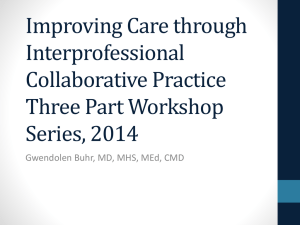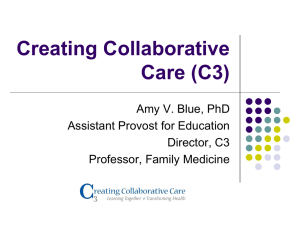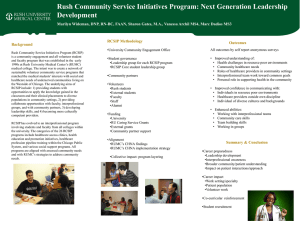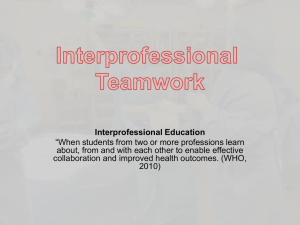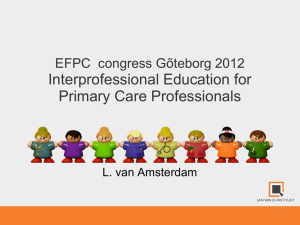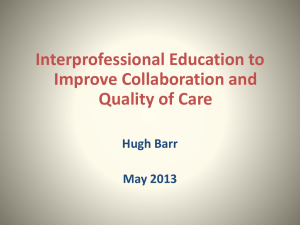Interprofessional Education at RBHS: The Quality Improvement
advertisement
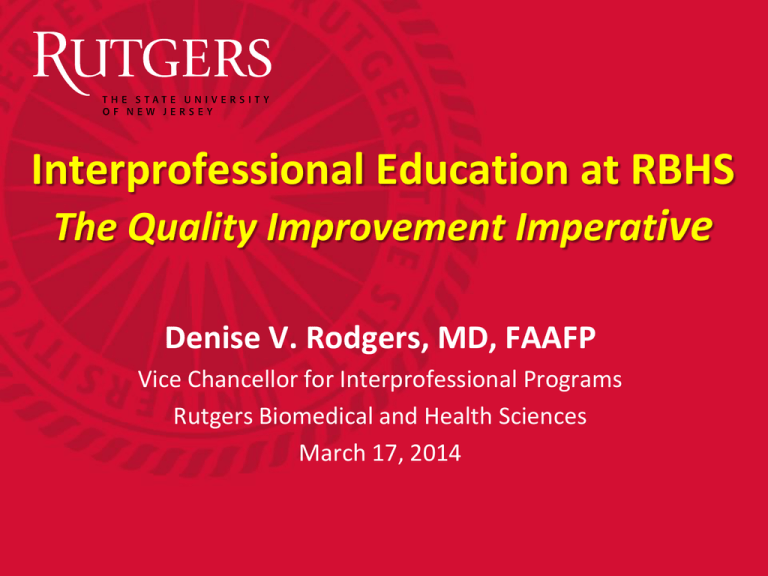
Interprofessional Education at RBHS The Quality Improvement Imperative Denise V. Rodgers, MD, FAAFP Vice Chancellor for Interprofessional Programs Rutgers Biomedical and Health Sciences March 17, 2014 WHO IPE DEFINITION “ Interprofessional education occurs when students from two or more professions learn about, from and with each other to enable effective collaboration and improve outcomes.” health WHO IP COLLABORATIVE PRACTICE DEFINITION “When multiple health workers from different professional backgrounds work together with patients, families, carers [sic], and communities to deliver the highest quality of care” Definition of interprofessionality “the process by which professionals reflect on and develop ways of practicing that provides an integrated and cohesive answer to the needs of the client/family/population… [I]t involves continuous interaction and knowledge sharing between professionals, organized to solve or explore a variety of education and care issues all while seeking to optimize the patient’s participation… Interprofessionality requires a paradigm shift, since interprofessional practice has unique characteristics in terms of values, codes of conduct, and ways of working. These characteristics must be elucidated” HEALTHCARE AND BASKETBALL Highly Functioning Interprofessional Teams Improve Access to Care! Highly Functioning Interprofessional Teams Improve Job Satisfaction! Highly Functioning Interprofessional Teams Improve Health Outcomes! AND WE NEED ALL THE IMPROVEMENT WE CAN GET!!!! IOM Definition of Quality • Safe • Effective • Efficient • Patient Centered • Timely • Equitable IHI 100,000 Lives Campaign Six Interventions • Deployment of Rapid Response Teams • Delivery of Reliable, Evidence-Based Care for Acute Myocardial Infarction • Prevention of Adverse Drug Events (ADEs) IHI 100,000 Lives Campaign Six Interventions • Prevention of Central Line Infections • Prevention of Surgical Site Infections • Prevention of Ventilator-Associated Pneumonia IHI 100,000 Lives Campaign Deployment of Rapid Response Teams Who will comprise the Rapid Response Team? Our experience shows that multiple models work well, including the following: • ICU RN, RT, Intensivist or Hospitalist • ICU RN and Respiratory Therapist (RT) • ICU RN, RT, Intensivist, Resident • ICU RN, RT, Physician Assistant • ED or ICU RN IHI 100,000 Lives Campaign Deployment of Rapid Response Teams • “Select each member (physician, RN, RT) of the Rapid Response Team carefully. The physician team member should be one who is respected by both nurses and physicians and perceived as a good communicator and team player.” IHI 100,000 Lives Campaign Deployment of Rapid Response Teams “In every model, there are four key features of Rapid Response Team members: • The team members must be available to respond immediately when called. • They must be onsite and accessible. • They must have the critical care skills necessary to assess and respond. • They must respond to every call with a smile on their face and a script that may include, “Thank you for calling. How can I help you?” IHI Triple Aim • Improving Population Health – (Better Health) • Improving the Patient Experience of Care – (Better Health Care) • Reducing Per Capita Cost – (Lower Cost) IHI Triple Aim Key Measurement Principles • Need a Defined Population • Need to Track Data Over Time • Must Distinguish Between Outcome and Process Measures IHI Triple Aim Key Measurement Principles • Must Distinguish Between Population and Project Measures • Need to Identify Benchmark or Comparison Data to Measure Progress Against IHI Triple Aim Population Health Outcome Measures • Life Expectancy • Years of Potential Life Lost • Health and Functional Status IHI Triple Aim Population Health Outcome Measures • Healthy Life Expectancy • Disease Burden • Behavioral Factors (Smoking, Exercise, Diet) • Physiological Factors (BP, BMI, Chol, Glucose) IHI Triple Aim Experience of Care Outcome Measures • Patient Surveys – Consumer Assessment of Healthcare Providers and Systems (CAHPS) – How’s Your Health Surveys – Likelihood to Recommend Surveys IHI Triple Aim Per Capita Cost Measures • Total Cost per Member of the Population per Month • Hospital and Emergency Department Utilization Rate and/or Cost WE BELIEVE THAT HIGHLY EFFECTIVE INTERPROFESSIONAL EDUCATIONAL EXPERIENCES ARE THE MOST EFFECTIVE WAYS OF TRAINING HEALTH PROFESSIONS STUDENTS TO WORK AS MEMBERS OF INTERPROFESSIONAL TEAMS Core Competencies for Interprofessional Collaborative Practice Core Competencies for Interprofessional Collaborative Practice 1: Values/Ethics for Interprofessional Practice 2: Roles/Responsibilities 3: Interprofessional Communication 4: Teams and Teamwork Core Competencies for Interprofessional Collaborative Practice 1: Values/Ethics for Interprofessional Practice These values and ethics are patient centered with a community/population orientation, grounded in a sense of shared purpose to support the common good in health care, and reflect a shared commitment to creating safer, more efficient, and more effective systems of care. They build on a separate, profession-specific, core competency in patient-centeredness. Core Competencies for Interprofessional Collaborative Practice 2: Roles/Responsibilities Learning to be interprofessional requires an understanding of how professional roles and responsibilities complement each other in patientcentered and community/population oriented care. Core Competencies for Interprofessional Collaborative Practice 3: Interprofessional Communication Communication competencies help professionals prepare for collaborative practice. Communicating a readiness to work together initiates an effective interprofessional collaboration Core Competencies for Interprofessional Collaborative Practice 4: Teams and Teamwork Teamwork behaviors involve cooperating in the patient-centered delivery of care; coordinating one’s care with other health professionals so that gaps, redundancies, and errors are avoided; and collaborating with others through shared problemsolving and shared decision making, especially in circumstances of uncertainty . HYPERTENSION • • • • Pharmacists Advance Practice Nurses Primary Care Physicians Sub-specialty Physicians • • • • What role does each play in managing HTN? What role could each play in managing HTN? What knowledge base should we expect from each? What knowledge is in common and what is different? The Interprofessional Practice Team at Chandler • • • • • • • • • • Receptionists Medical Assistants LPNs/RNs Nutritionists Social Workers Pharmacy Students and Faculty Residents and Faculty Physicians Nurse Practitioner Medical Interpreters Security Guard SOME OF MY QUESTIONS • WHAT ARE OUR STUDENTS AND RESIDENTS CURRENTLY LEARNING ABOUT INTERPROFESSIONAL TEAM WORK? • WHAT ARE THE ATTITUDES OF RBHS FACULTY ABOUT INTERPROFESSIONAL EDUCATION AND PRACTICE? • WHERE IS HIGHLY EFFECTIVE INTERPROFESSIONAL CARE BEING PROVIDED WITHIN RUTGERS HEALTH? • WHERE IS HIGHLY EFFECTIVE INTERPROFESSIONAL EDUCATION BEING PROVIDED WITHIN RBHS? SOME OF MY QUESTIONS • HOW MUCH, AND WHAT TYPES OF INTERPROFESSIONAL LEARNING EXPERIENCES DO STUDENTS NEED? • HOW DO WE MEASURE COMPETENCE IN INTERPROFESSIONAL TEAMWORK? • HOW DO WE IMPROVE PROFESSIONALISM AND “CIVILITY” IN THE CLINICAL ENVIRONMENT? • SHOULD WE MORE OVERTLY EVALUATE FACULTY, RESIDENTS, AND STUDENTS ON THEIR ABILITY TO PRODUCTIVELY WORK AS MEMBERS OF INTERPROFESSIONAL TEAMS? SOME OF MY QUESTIONS • HOW DO WE DEVELOP MEASURES TO EVALUATE STUDENTS AND RESIDENT SKILLS IN INTERPROFESSIONAL TEAM WORK? • ARE WE TRAINING OUR STUDENTS AND RESIDENTS TO BE INTERPROFESSIONAL TEAM LEADERS? • HOW DO WE DEAL WITH TEAM MEMBERS WHO DON’T BEHAVE PROFESSIONALLY? • HOW DO WE DEAL WITH TEAM MEMBERS WHOSE FUND OF KNOWLEDGE MAY BE INADEQUATE? SOME OF MY QUESTIONS • HOW DO WE BEGIN TO IDENTIFY OVERLAPS IN PRACTICE AND DISTINGUISHING SKILL SETS BETWEEN PROFESSIONS? • WHAT PERCENTAGE OF THE KNOWLEDGE AND SKILLS OF A PRIMARY CARE PHYSICIAN OVERLAP WITH THE KNOWLEDGE AND SKILLS OF A PRIMARY CARE NURSE PRACTITIONER OR A PRIMARY CARE PHYSICIAN ASSISTANT? WHY DOES IT MATTER? • SHOULD PATIENTS KNOW THE DIFFERENCE BETWEEN A DOCTOR WHO IS A PHYSICIAN AND A DOCTOR WHO IS A NURSE? • HOW DO WE INCORPORATE NON-RBHS HEALTH CARE WORKERS INTO OUR EDUCATIONAL PROGRAMS? Your Comments and Questions
